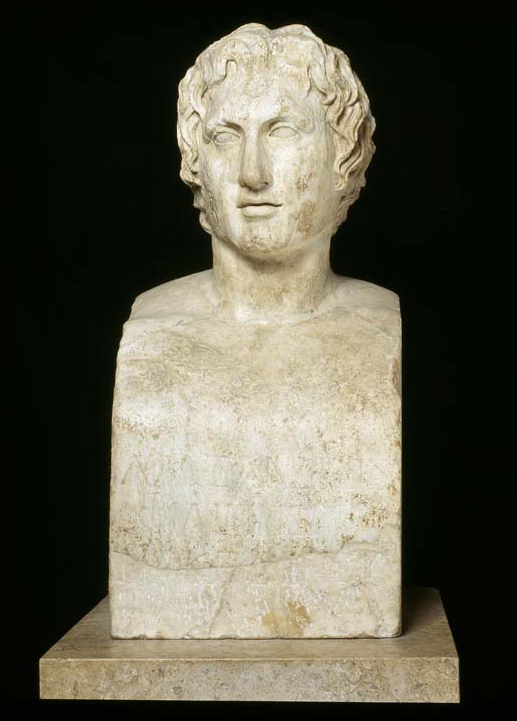Azara Herm
Title
Date
Artist or Workshop
Original Artist- Lysippos
Materials
Greek Original- Bronze
Height of the work
Provenience
Current Location
Sitter Biography
Description and Significance
The Azara herm is a life-size herm statue that portrays the head of a male attached to a pillar. The statue has been badly damaged over time, leaving it with a weathered appearance. Inscribed on the pillar in ancient Greek is “Alexander the Macedonian son of Philip”. The face is that of a beardless and youthful male. There are some incisions and marks across the face, but these were the result of the statue being buried for hundreds of years. The head is raised and facing off to the right, giving him a tilted and upwards glance. The lips are parted slightly, as if the statue were getting ready to speak. The blank eyes, which once would have been painted in, give off a melting gaze. The statue has long and thick waves of hair, parted in the middle, which entirely encompasses the right ear; The left ear is poking out through the hair. Above the central point of the forehead, the locks of hair stand straight up in the anastole fashion.
SIGNIFICANCE
The Azara herm is considered one of the best Roman replicas of the works of Lysippos. Lysippos was chosen by Alexander the Great to be his court sculptor, and was the only person allowed to craft his image. Alexander was extremely concerned with how he was portrayed, leading to one official, carefully controlled image. This would be disseminated throughout his massive empire, allowing people from throughout the lands to know not only what their leader looked like, but the type of person that he was. This herm statue contains a mixture of naturalized and realistic features. The cheekbones and nose are more natural features, while details such as the neck tilt, “melting eyes”, parted lips and anastole hair are clearly indicative of Alexander the Great. The base of the figure was naturalized but was overlaid with realistic features which give a much more individualized appearance. The bare face was a direct contrast to the typically bearded rulers of ancient Greece. His slight neck tilt and upwards gaze represented power and strength and would go on to become the standard iconography for Hellenistic kingdoms. Through sculpture, Lysippos was able to capture Alexanders natural born ruling abilities, as well as his “leonine quality”.
References
Heckel, Waldemar. Tritle, Lawrence A. "Alexander the Great: A New History". John Wiley & Sons, September 2011. pp. 279-284
Bieber, Margarete. “The Portraits of Alexander.” Greece & Rome, vol. 12, no. 2, 1965, pp. 183–188. JSTOR
Contributor
Citation
Item Relations
This item has no relations.

